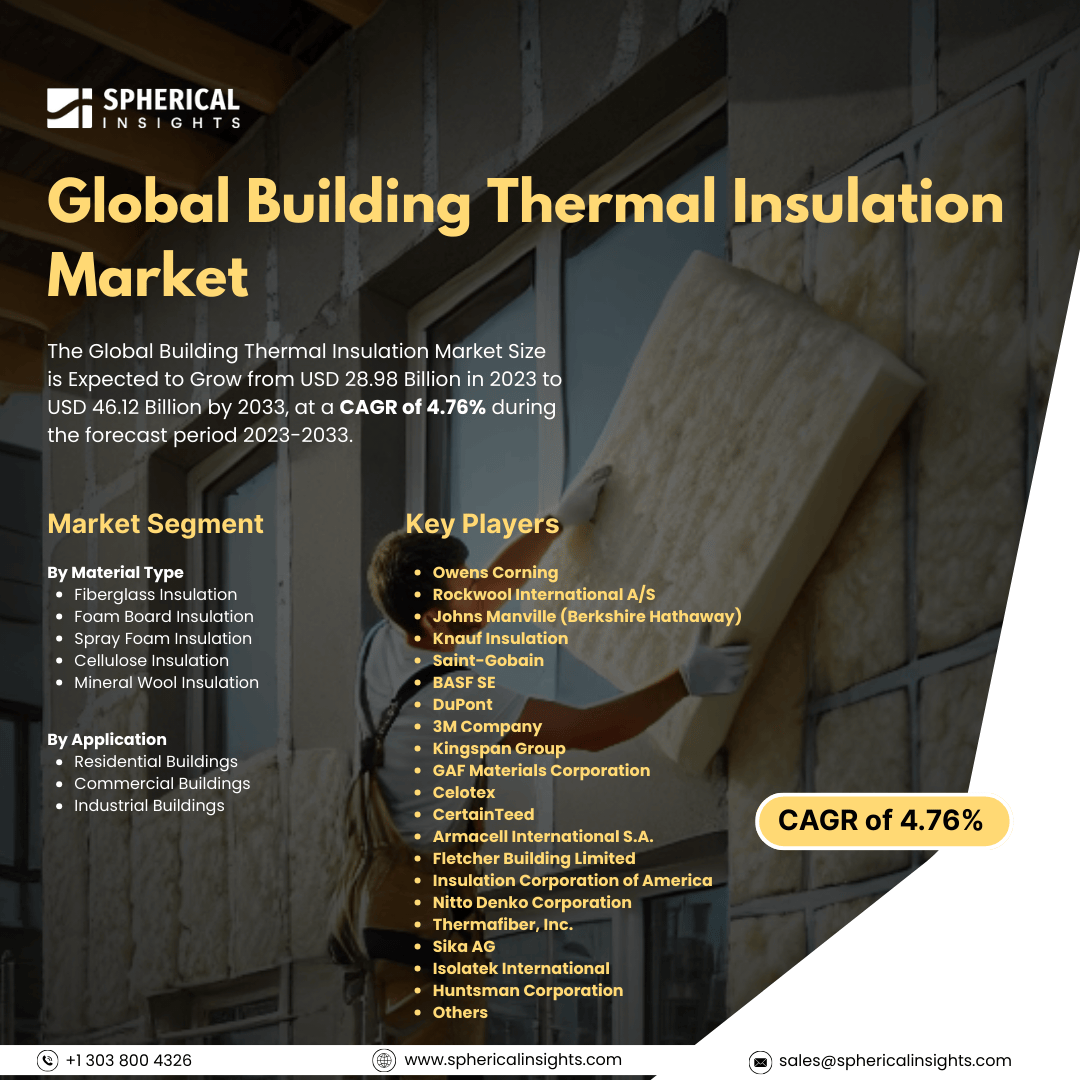Global Building Thermal Insulation Market Size to worth USD 46.12 Billion by 2033
According to a research report published by Spherical Insights & Consulting, The Global Building Thermal Insulation Market Size is Expected to Grow from USD 28.98 Billion in 2023 to USD 46.12 Billion by 2033, at a CAGR of 4.76% during the forecast period 2023-2033.
Browse key industry insights spread across 210 pages with 110 Market data tables and figures & charts from the report on the Global Building Thermal Insulation Market Size, Share, and COVID-19 Impact Analysis, By Material Type (Fiberglass Insulation, Foam Board Insulation, Spray Foam Insulation, Cellulose Insulation, and Mineral Wool Insulation), By Application (Residential Buildings, Commercial Buildings, and Industrial Buildings), and By Region (North America, Europe, Asia-Pacific, Latin America, Middle East, and Africa), Analysis and Forecast 2023 – 2033.
The market that produces, distributes, and uses materials to lessen heat transmission in buildings is known as the building thermal insulation market. These materials contribute to minimizing greenhouse gas emissions, energy utilization, and a comfortable indoor temperature. Cellulose, plastic foam, stone wool, and glass wool are common insulating materials. Growing awareness of sustainability, stricter environmental restrictions, and rising demand for energy-efficient buildings are driving the industry. Climate change and rising energy costs are driving building owners and contractors to improve thermal insulation, which reduces energy consumption for heating and cooling, enhances indoor climate control, and improves occupant comfort. Factors driving interest in well-insulated buildings include population growth, urbanization trends, rising utility bills, and the demand for green buildings by the younger generation. Real estate developers also see energy efficiency as a marketing point to attract tenants and buyers willing to pay a premium for properties with lower operating costs. Overall, sustainable construction is becoming increasingly important for reducing energy consumption and enhancing indoor comfort. However, the global building thermal insulation market faces challenges due to the high initial costs of advanced materials, budgeting issues, and lack of awareness about life-cycle cost savings.
The fiberglass insulation segment accounted for 34.44% of the market share in 2023 and is expected to grow at a significant CAGR during the forecast period.
Based on the material type, the building thermal insulation market is classified into fiberglass insulation, foam board insulation, spray foam insulation, cellulose insulation, and mineral wool insulation. Among these, the fiberglass insulation segment accounted for 34.44% of the market share in 2023 and is expected to grow at a significant CAGR during the forecast period. This is because of its balanced performance features and adaptability. Molten glass is spun into extremely fine strands to create fiberglass insulation, which is then cut into mats that can be installed between attic joists or wall studs. It helps control heat and cold and has good thermal resistance, making indoor spaces comfortable all year round.
The residential buildings segment accounted for 36.98% of the market share in 2023 and is expected to grow at a significant CAGR during the forecast period.
Based on the application, the building thermal insulation market is divided into residential buildings, commercial buildings, and industrial buildings. Among these, the residential buildings segment accounted for 36.98% of the market share in 2023 and is expected to grow at a significant CAGR during the forecast period. This is mostly because so many homes throughout the world need insulation for comfort and energy efficiency. Since there are just more homes than any other kind of structure, individual residences represent a higher demand for insulating materials than other building kinds.
North America is estimated to hold the largest share of the building thermal insulation market over the forecast period.
North America is estimated to hold the largest share of the building thermal insulation market over the forecast period. The U.S.'s established residential and commercial construction sectors, coupled with strict energy efficiency regulations, have driven the demand for high-performing insulation materials in retrofits and new construction. Leading manufacturers have shifted production capacities and innovation efforts to cater to this influential customer base.
Asia Pacific is predicted to have the fastest CAGR growth in the building thermal insulation market over the forecast period. Developing nations like China and India are seeing tremendous infrastructure growth due to rapid urbanization and industrialization. New residential and commercial real estate is being developed at previously unheard-of rates in both countries. The adoption of thermal insulation to satisfy sustainability goals and reduce energy costs during a building's lifetime has increased as a result of this surge in construction activity.
Company Profiling
Major key players in the building thermal insulation market include Owens Corning, Rockwool International A/S, Johns Manville (Berkshire Hathaway), Knauf Insulation, Saint-Gobain, BASF SE, DuPont, 3M Company, Kingspan Group, GAF Materials Corporation, Celotex, CertainTeed, Armacell International S.A., Fletcher Building Limited, Insulation Corporation of America, Nitto Denko Corporation, Thermafiber, Inc., Sika AG, Isolatek International, Huntsman Corporation, and Others.
Key Target Audience
- Market Players
- Investors
- End-users
- Government Authorities
- Consulting And Research Firm
- Venture capitalists
- Value-Added Resellers (VARs)
Market Segment
This study forecasts revenue at global, regional, and country levels from 2023 to 2033. Spherical Insights has segmented the building thermal insulation market based on the below-mentioned segments:
Global Building Thermal Insulation Market, By Material Type
- Fiberglass Insulation
- Foam Board Insulation
- Spray Foam Insulation
- Cellulose Insulation
- Mineral Wool Insulation
Global Building Thermal Insulation Market, By Application
- Residential Buildings
- Commercial Buildings
- Industrial Buildings
Global Building Thermal Insulation Market, By Regional Analysis
- North America
- Europe
- Germany
- UK
- France
- Italy
- Spain
- Russia
- Rest of Europe
- Asia Pacific
- China
- Japan
- India
- South Korea
- Australia
- Rest of Asia Pacific
- South America
- Brazil
- Argentina
- Rest of South America
- Middle East & Africa
- UAE
- Saudi Arabia
- Qatar
- South Africa
- Rest of the Middle East & Africa



